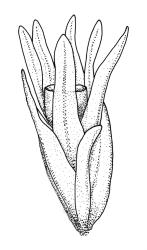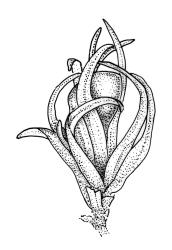- ≡ Muelleriella aucklandica Vitt, J. Hattori Bot. Lab. 40: 94 (1976)
Plants in small, nearly black cushions, the tips often yellow-green to light green. Stems erect, mostly 2–4 times branched, rarely simple or once-branched, c. 3–12 mm. Leaves twisted and inwardly curved when dry, erect-spreading and straight or slightly secund when moist, ligulate-lanceolate to narrowly ligulate from an ovate base, broadly obtuse to sometimes acute, 2–3-stratose above, entire, plane, 1.8–3.0(–3.9) mm (including perichaetial); margins 2–4-stratose; mid and upper laminal cells irregularly rounded to irregularly hexagonal, a few usually oblate, smooth, mostly 5–9 µm wide; interior basal cells rectangular to elongate-rectangular, mostly 24–45 × c. 12 µm, slightly nodose toward the costa, shorter but lacking thickened walls at margins. Costa as per genus, stout, elliptic in cross-section at mid leaf, ending just below apex, obscured in surface view by laminal cells near apex. Gemmae lacking.
Gonioautoicous. Perichaetial leaves larger but otherwise similar to vegetative. Perigonia gemmiform or at the ends of separate branches. Setae stout, (0.4–)0.8–1.1 mm; capsules oblong and ± constricted below the mouth when dry, ovate-oblong to globose-ovate when moist, immersed, pale yellow-brown, the mouth reaching the upper half of the perichaetial leaves; gradually or abruptly narrowed to the seta, (0.8–)1.0–1.2 × 0.7–0.8 mm; exothecial cells rectangular, mostly 21–30 µm, with a faintly striate cuticle; stomata immersed, restricted to lower half of capsule; annulus absent; operculum not seen. Peristome single; exostome teeth 16, spreading when dry, recurved when old and dry; papillose; preperistome well-developed, sometimes up to ½ length of the exostome; endostome absent. Calyptra conic-mitrate, naked or nearly so, with small papillae near the apex. Spores multicellular, irregularly spherical to cubic-rectangular, 40–70 µm.
Vitt 1976, figs 1–7, 36 (as Muelleriella aucklandica).
Orthotrichum aucklandicum is distinguished from O. angustifolium by differences in habit, leaf shape, and leaf length (see Vitt 1976, fig. 32). While differences in capsule dimension and form are less convincing than suggested by Vitt, the position of the capsule mouth in relation to the enclosing perichaetial leaves appears to be a more consistent character; this is best observed in dry plants.
Orthotrichum aucklandicum is best distinguished from O. crassifolium by sporophyte characters. In the present species the capsules are immersed, and ovate-oblong to nearly globose when moist. The gametophyte characters separating O. aucklandicum from O. crassifolium seem less convincing, and sterile material from areas where their ranges overlap cannot be confidently distinguished. Collection data suggest that O. aucklandicum may be less tolerant of salt spray than O. crassifolium.
A (Lake Hinemoa, Falla Peninsula, near Logan Point, above Victoria Passage).
Endemic.
Occurring on boulders, cliff faces and rock ledges at elevations from 25 to 365 m on the Auckland Is.
Orthotrichum aucklandicum is extremely poorly documented; it has been collected from four localities on Auckland I. and Adams I.
Although Vitt (1976, p. 96) described the capsules of O. aucklandicum as "more or less oblong", material has been seen in which the moist capsules are nearly globose in form and abruptly narrowed to the seta when moist.








